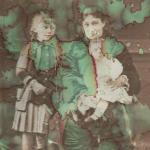MANKIND WITH NO NAME
MANKIND WITH NO NAME
Photography was born in 1839 from the experiments of Daguerre and Talbot. And since 1850 it was already in common use.
It was the first time that ordinary people could take a portrait. It was no longer necessary to be rich, a noble or a cleric and to pose before the painter. Photography spread everywhere, in all the cities there were photographers who with their contraption could make you a portrait so true that no painter could have gone that far. Then they handed it to you carefully pasted on a card and you could give it to your children, grandchildren, the people dear to you, so they could possess a fragment of you, your true imprint, not the painter’s artifice.
The portraits we have left speak of living people, a captured instant of their lives, generously donated to posterity. But alas, We today will never know anything about those women and men who keep looking at us silent but alive. Walter Benjamin called it “humanity without a name”. “In Hill’s New-haven fishwife”, he wrote on one of these images, “her eyes cast down in such indolent, seductive modesty, there remains something that goes beyond testimony to the photographer’s art, something that cannot be silenced, that fills you with an unruly desire to know what her name was, the woman who was alive there, who even now is still real and will never consent to be wholly absorbed in art”.
It is the miracle of photography and its enigma that remains. Not all photographers were artists, but all of them told the truth, even those who were reduced to retouching, to the theatrical setting, ostentatious, ridiculous even then.
These photos from the second half of the nineteenth century are of ordinary and today anonymous people. But they scream like wandering spirits who want to talk to you, because they exist.
Adding abstract stains on the photographs Michele Dolz seeks to bring these images to our present time. To make them thriving, so we can see these people too, as they seek to see us. And remember, and pay tribute to our past, our genitors, our families.
Our society’s collective past is a subject that Dolz first started working on 2018 with an installation called Ecce Homo, a tribute to his grandfather and the people of Castellon, Spain, in the end of the 19th Century. It was made of a printed photograph on canvas and jute bags, showed in the same year at Catellón, and later on at The National Exemplar Gallery in NYC.
Eneas Capalbo
New York, June 20th 2019
Portraits lost and regained
By Chiara Canali
Graham Clarke, in The Portrait in Photography, states that portraiture is one of the most problematic areas of photographic practice: "Portrait photography is full of ambiguity at almost all levels, in any context". Since the dawn of the photographic portrait, the photographers have focused the problem of expressing in a single image an alleged "interior". A good portrait captures a moment of immobility in the daily flows of things, showing the interiority of a person. Fascinated by the strength and mystery of a multitude of long-lost personalities, Michele Dolz discovered and collected in the markets photos from the second half of the nineteenth century. Faces in the foreground or half-length portraits of anonymous, unknown people who disappeared in the depths of history, but who still declare their presence and relevance today through a single image, torn from the flow of social events. The portraits convey to us something of a bygone era, on which the patina of time has settled. On these portraits Michele Dolz intervenes by depositing acid spots, corroding the black and white of the surface, to bring to light the sign of individual existences and unrepeatable stories. Dolz turns to the past memory, the individual memory of our families and ancestors, and the collective memory of our society, and brings back the emotional experience. Memory thus becomes an intimate place, of inner experiences and lost emotions experienced in the past, but then reconquered and updated in the present. Aware that the image will perhaps survive, Dolz considers himself to be the fragile, transitory element, while the image is the future element, the element of duration. His final image thus acquires more memory and more future than he who looks at it hic et nunc, in the present of vision.
